Casarecce Pasta Caponata
One of the most iconic dishes in Sicilian cooking is caponata. This sweet and sour Mediterranean veggie dish is delicious as a side with both meat and fish and, as in this recipe for casarecce pasta caponata, makes a fabulous pasta sauce! Pasta alla caponata is great warm or as a pasta salad.
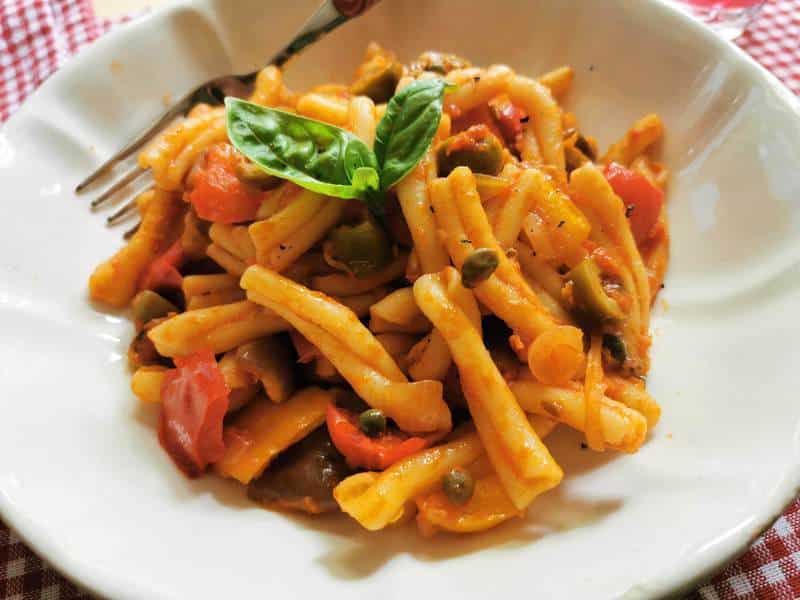
What is caponata?
Caponata is an eggplant based summer vegetable stew that Sicilians often serve as a cold antipasto or a side dish with fish. There are different recipes for this dish throughout Sicily. However, the usual basic ingredients are eggplant, celery, capers, onions, green olives, tomatoes, white wine vinegar and sugar. The latter are what give caponata its sweet and sour flavour.
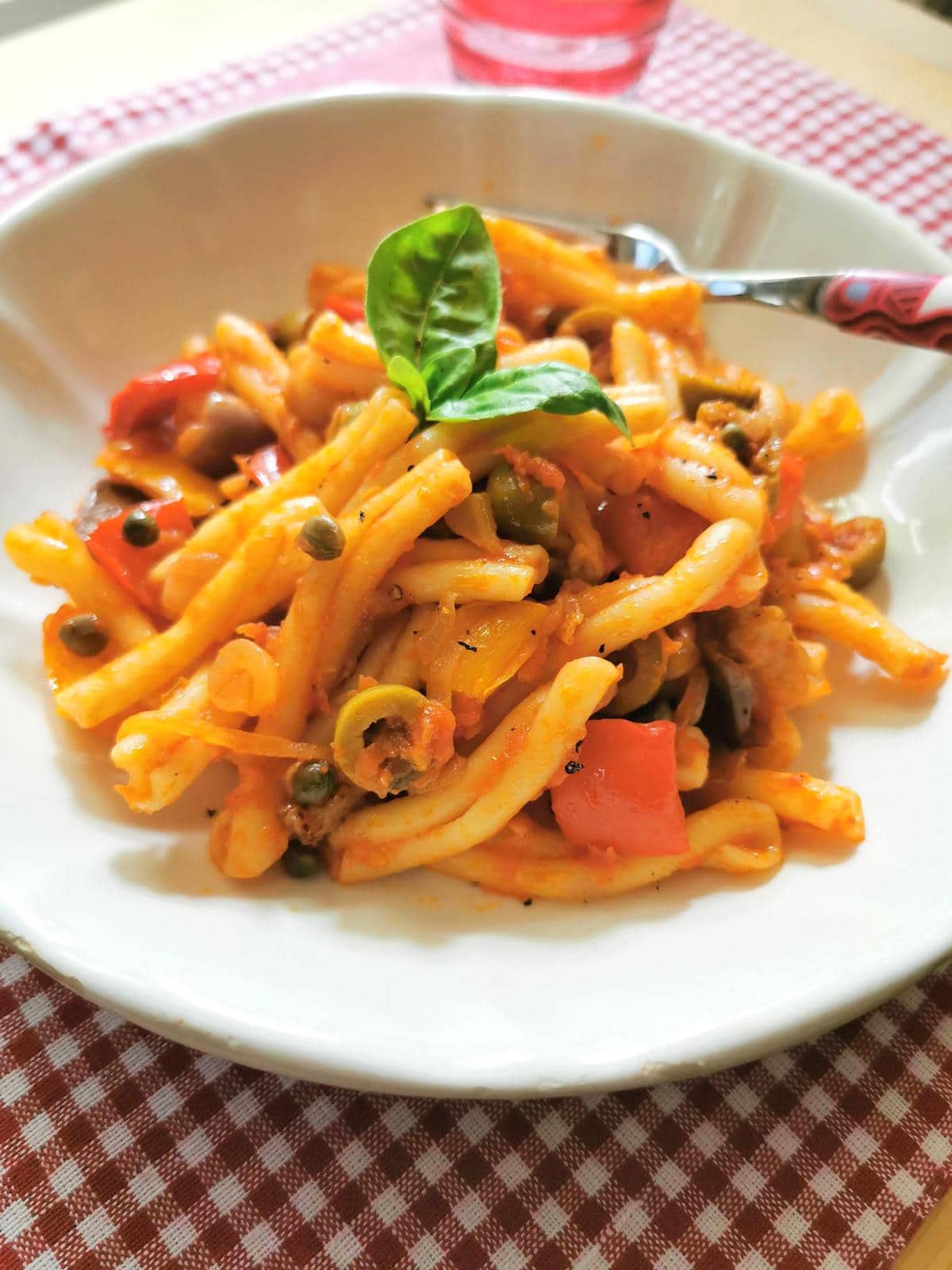
In this casarecce pasta caponata, I have included sweet red and yellow peppers (peperoni in Italian). This is apparently typical of the versions from Trapani and Catania. However, some recipes from Catania include peppers but others don’t!
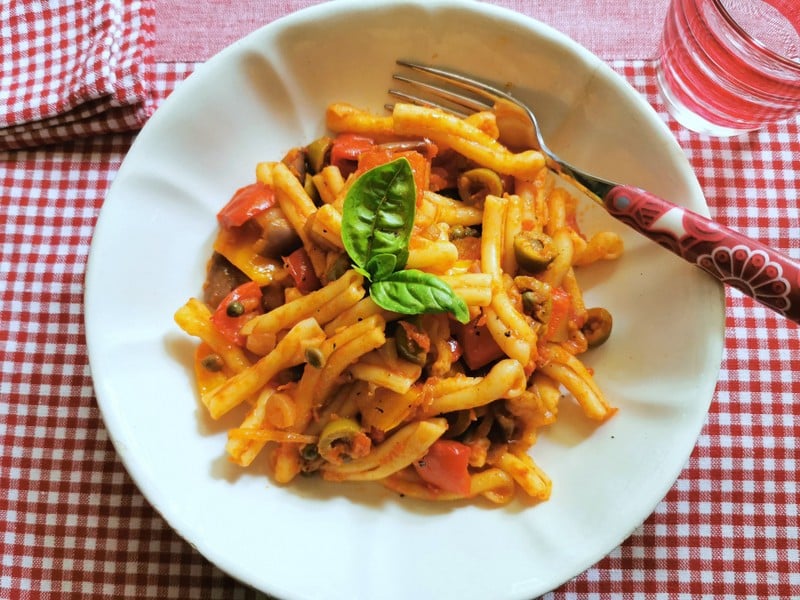
Other caponata recipes call for pine nuts, almonds, raisins, potatoes or garlic or fish. There are even versions with cocoa powder! Sicilians say there are more than 30 versions of this dish on the island!
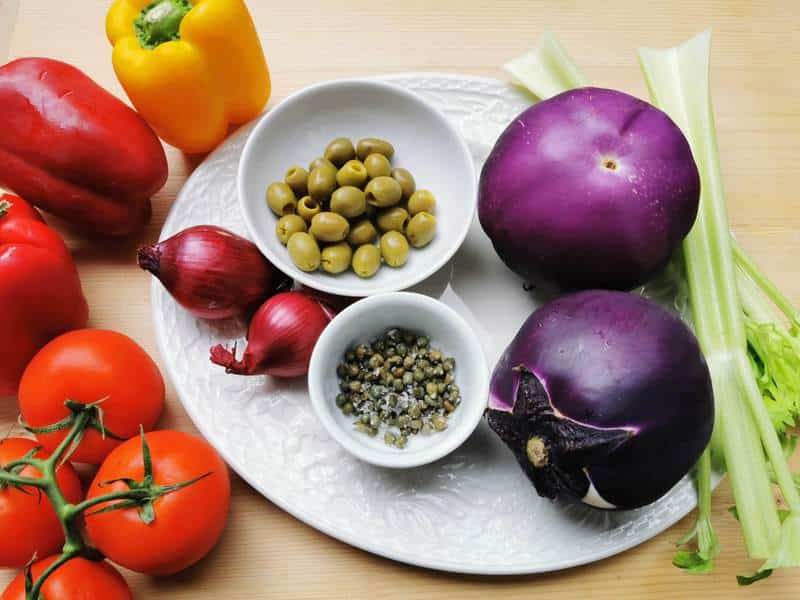
A little caponata history.
Sicilian caponata is similar to French ratatouille. However, according to food historians, caponata is older than ratatouille. In fact, caponata first appeared in written sources in the early 1700s. Some people believe the Spanish introduced this dish to Sicily. Others think it has Arab origins.
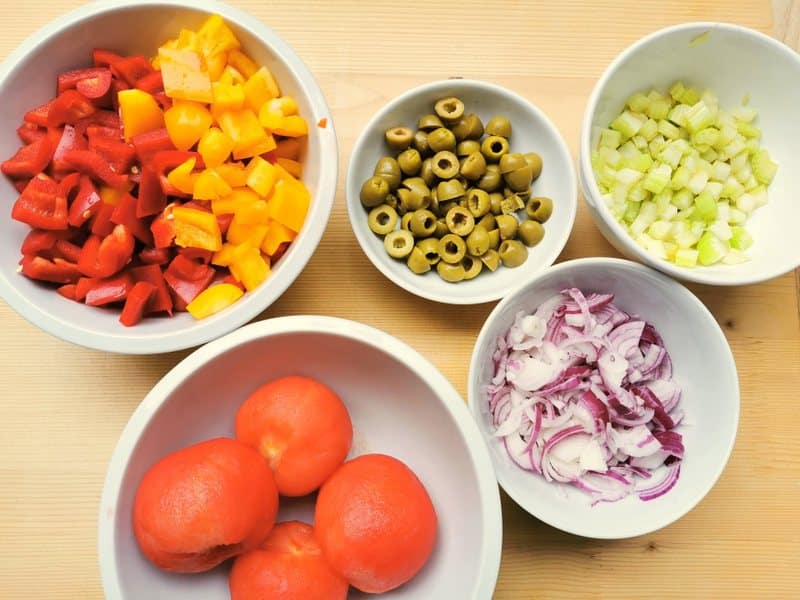
There are also various theories about the origin of the term ‘caponata’. In one theory, they say it derives from the capone or lambuga fish (mahi mahi), which Sicilians traditionally ate with a similar sweet and sour sauce. Another belief is that the name comes from the Latin noun ‘caupona’ (tavern) and from the adjective ‘cauponia’, meaning ‘tavern food’. Of course, there are other theories too.
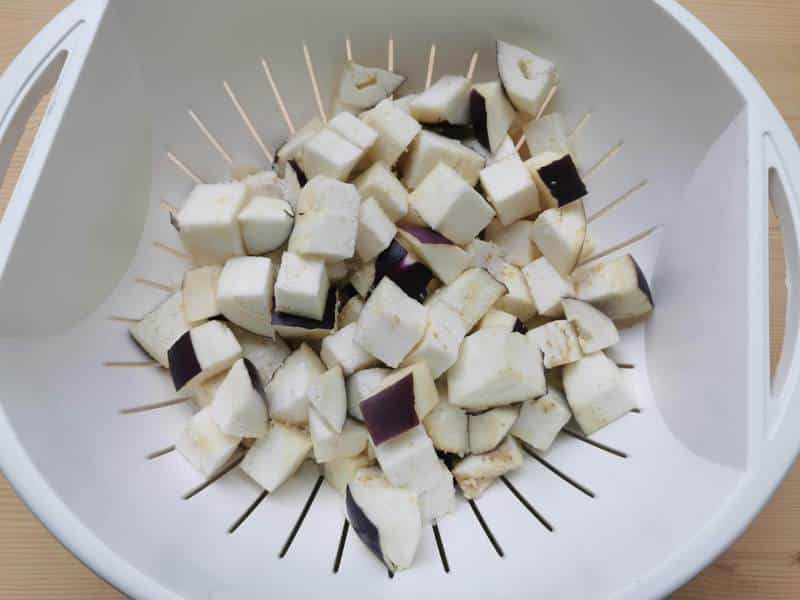
In the past, caponata was normally a one plate meal accompanied by bread, often a dried bread. Originally, the wealthier aristocratic Sicilians used to consume a fish-based caponata. Over time, the fish was replaced by eggplants among the poorer population, who could not afford to buy fish. Capone, in particular, was an expensive and much sought after fish.
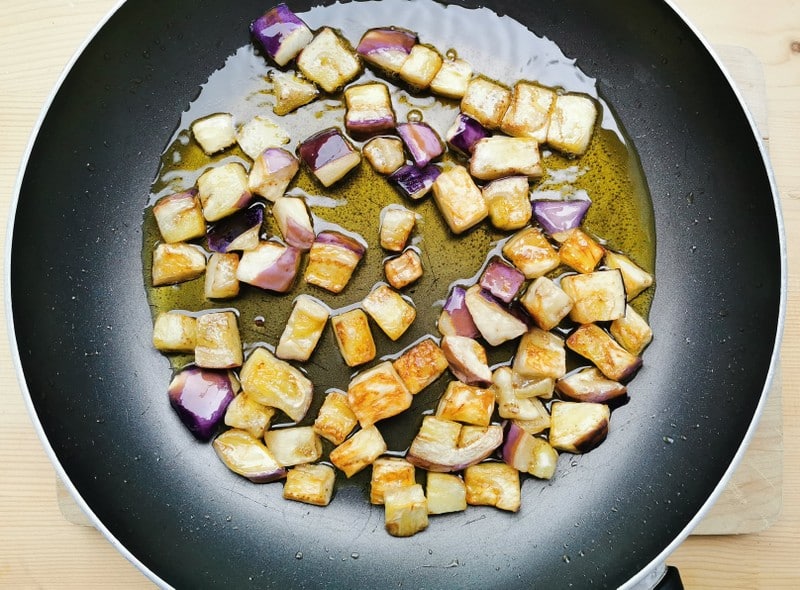
There’s a recipe for a fish-based caponata in an 1839 cookbook called ‘Theoretical and practical cuisine’ by Ippolito Cavalcanti. This recipe is quite rich and consists of a sort of toasted bread (perhaps today's freselle) soaked with vinegar and seasoned with sugar, salt, pepper, oil, capone fish (sometimes replaced by mackerel), lettuce, escarole, cucumber, olives and sweet peppers!
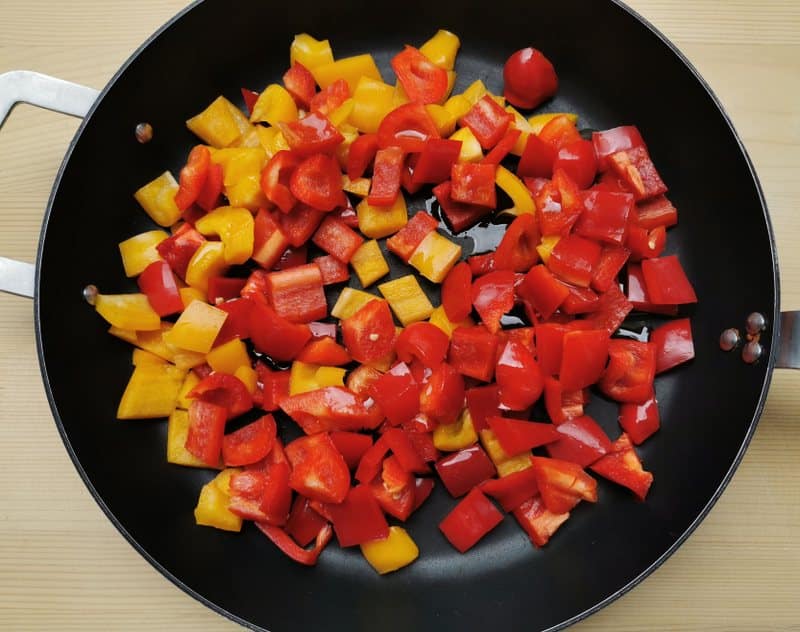
In some places, they still sometimes make caponata with capone or even octopus. However, nowadays the most popular fish pairings are grilled or pan fried swordfish or fresh tuna.
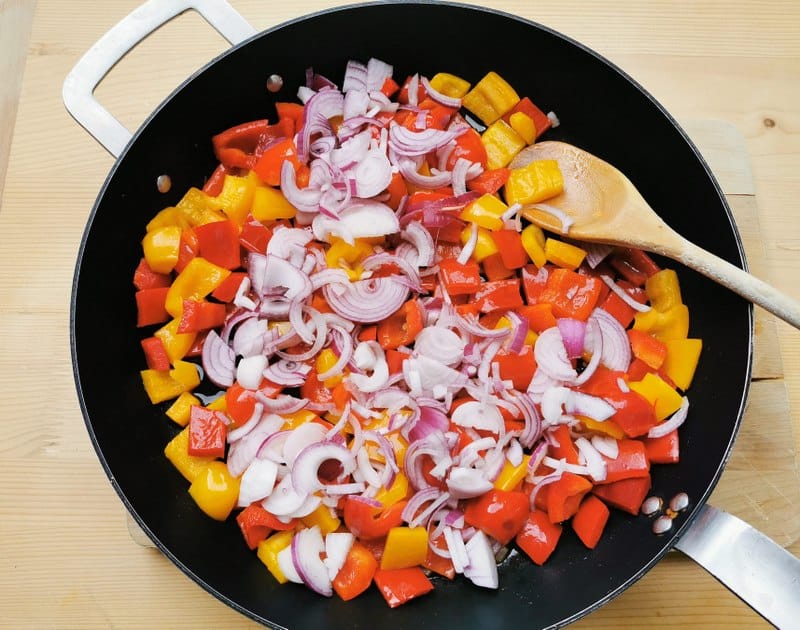
The eggplants.
The Arabs introduced eggplants to the Sicilians in the 15th century. Eggplants (or you might call them aubergines) are to Sicily what potatoes are to Ireland. There are three main kinds of eggplants cultivated in Sicily; the very dark oval or long ones that most people outside of Italy know, long zebra eggplants which have a lighter striped skin and the more rotund, lighter coloured Sicilian eggplant.
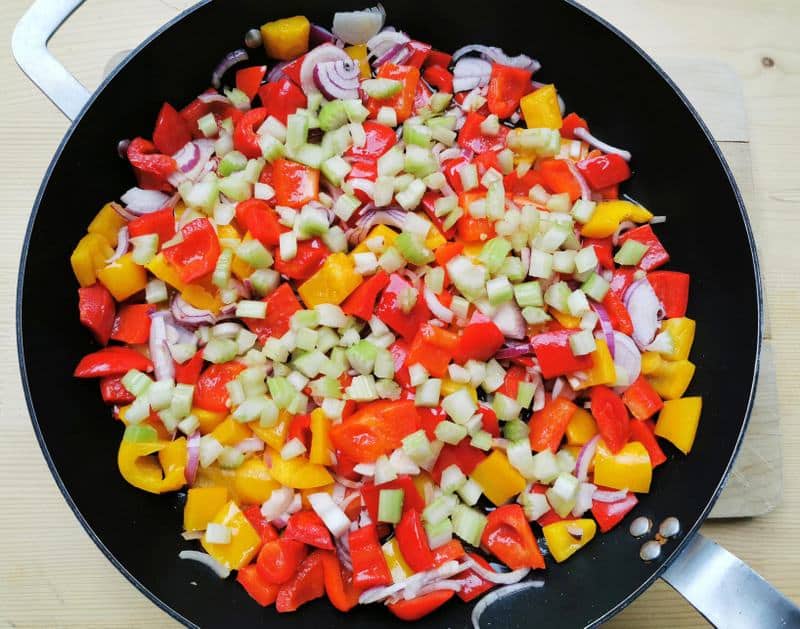
The lighter coloured round Sicilian eggplants are what I used for this casarecce pasta caponata. This type of eggplant has a dense whiter flesh and less seeds than the others, but of course you can use whichever you find available.
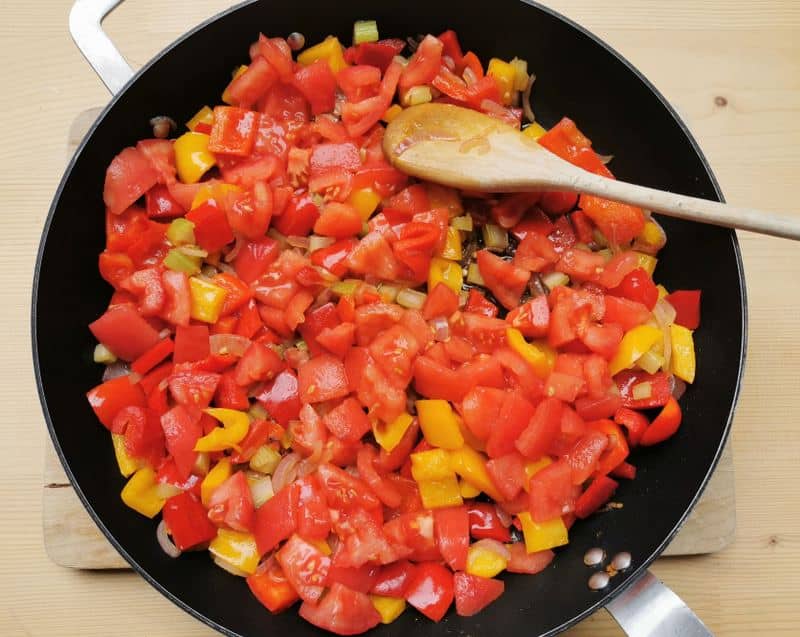
You will need to cut the eggplant into cubes and salt it for 30-60 minutes before rinsing and frying it. So it’s probably best to salt the eggplant before preparing the other ingredients. Some people say that salting isn’t necessary but I find that the eggplant absorbs less olive oil when you salt it beforehand.
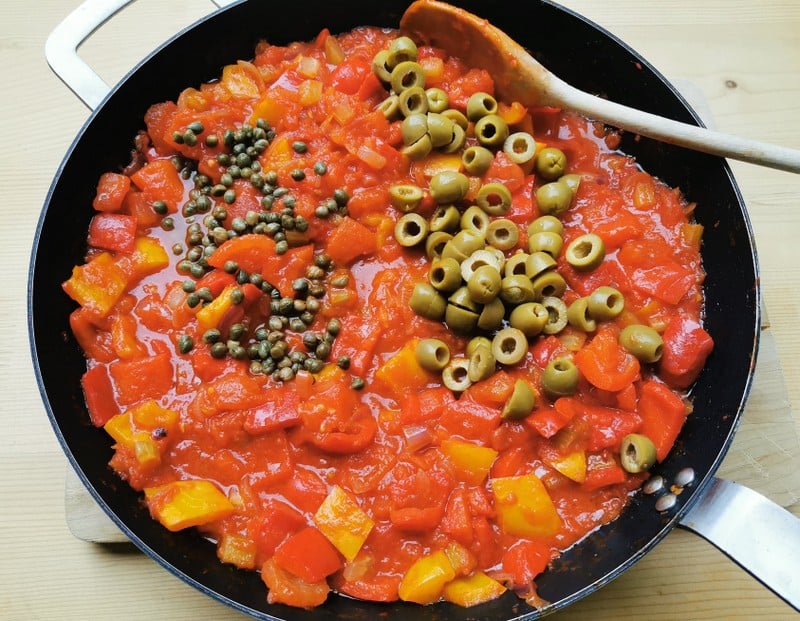
Different ways to make caponata.
My Sicilian hubby tells me that the proper way to make caponata is to cook each ingredient separately and then put it together. However, I’ve found as many variations in the method as versions of the recipe! For this casarecce pasta caponata, I just fried the eggplant separately after salting it.
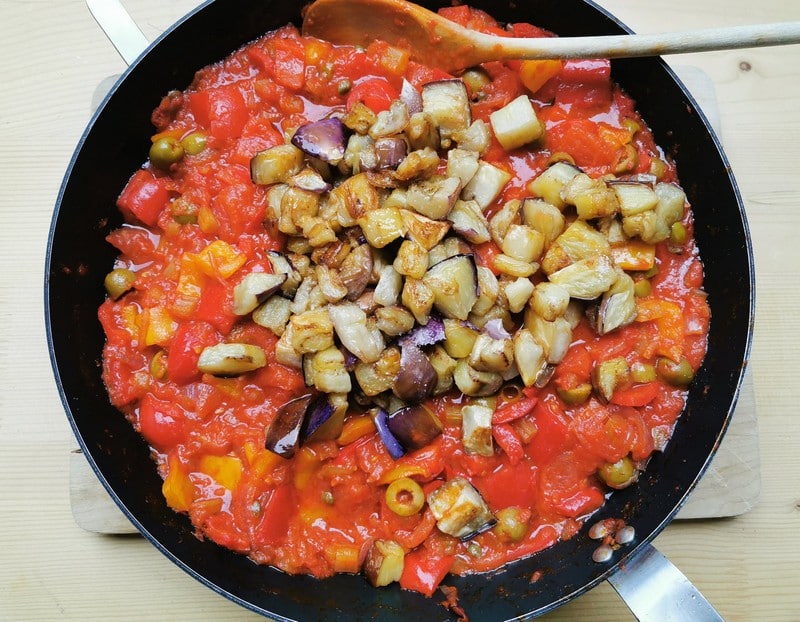
I cooked the rest of the ingredients together in the same skillet. Starting with the peppers, then adding the onions, then the celery followed by the tomatoes then the olives and capers. Once everything was cooked I put in the fried eggplant and then the vinegar and sugar! The result was fantastic!
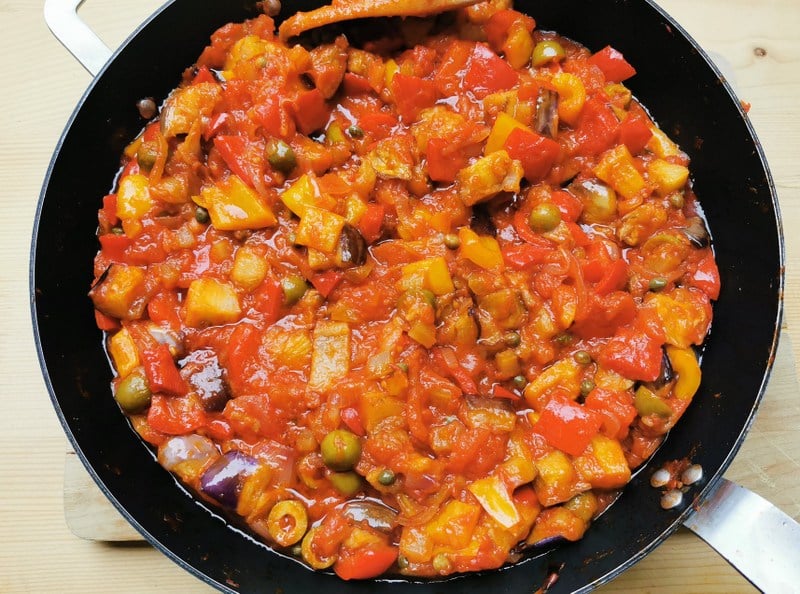
Caponata can be eaten as a side dish as well as a salad. This casarecce pasta caponata is also fabulous as a salad and can be kept in the fridge for 2-3 days. It’s vegan and vegetarian so there are is no meat or dairy that can spoil quickly.
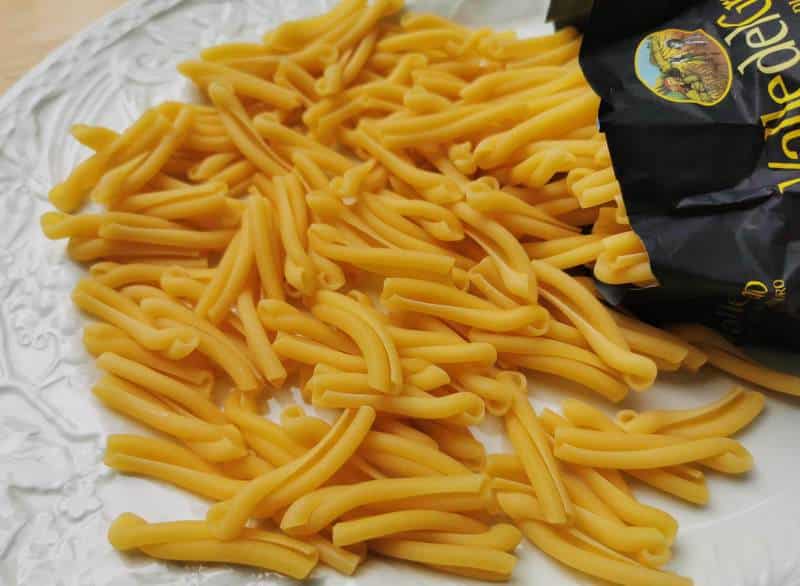
The pasta.
Nearly all pasta salads are made with short pasta here in Italy. I used casarecce, one of my favourite Southern Italian pasta shapes. Casarecce is short pasta noodles with curled edges and a groove down the middle. It looks a little like small rolled up scrolls. You can read more about this pasta in my casarecce post.
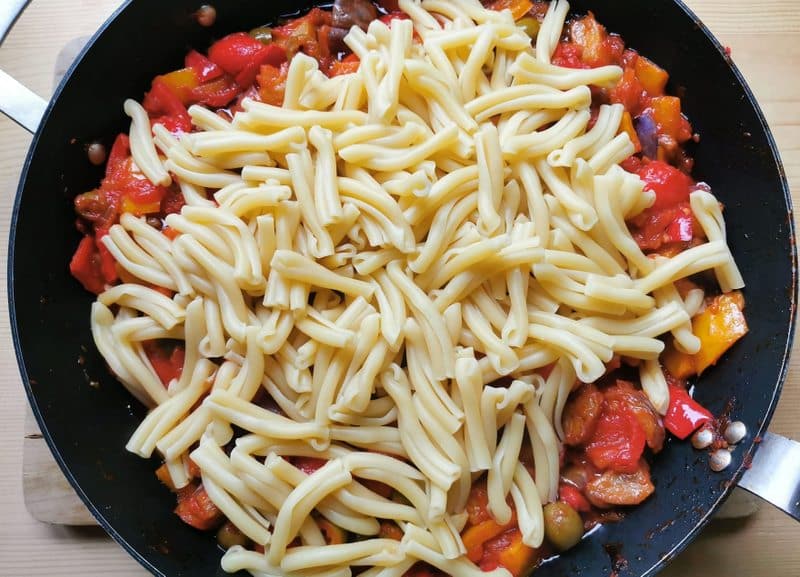
Like caponata, casarecce is originally from Sicily. In fact, the casarecce I used was made by one of the best pasta companies in Sicily. My hubby brought it back for me the last time he was there. This company is called Valle del Grano.
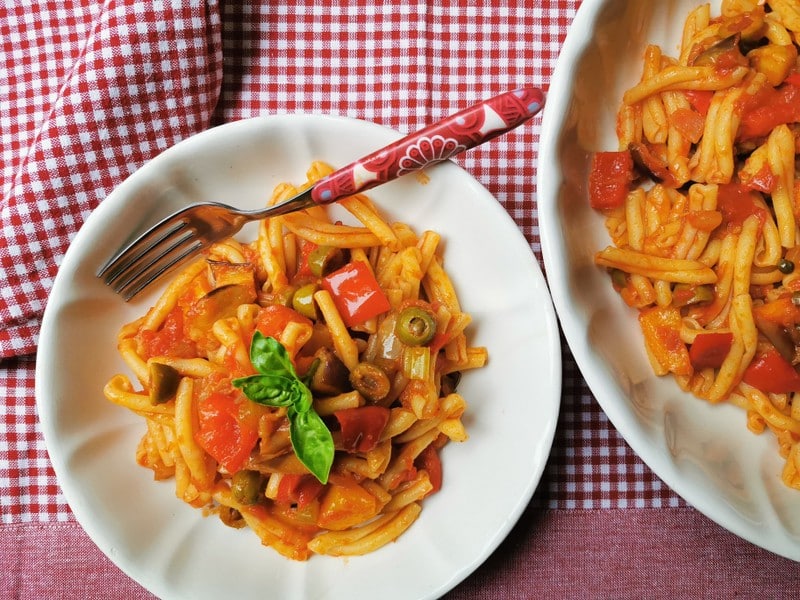
In my opinion, the best pasta in Italy is made by brands that use 100% Italian wheat (preferably organic), extrude the dough through bronze dies and slow dry it. Valle del Grano ticks all those boxes. They make their pasta with 100% Sicilian durum wheat grown in the Dittaino valley between Catania and Enna. Durum wheat has been grown in this area since Roman times. Their pasta is also extruded through bronze dies and slow dried.
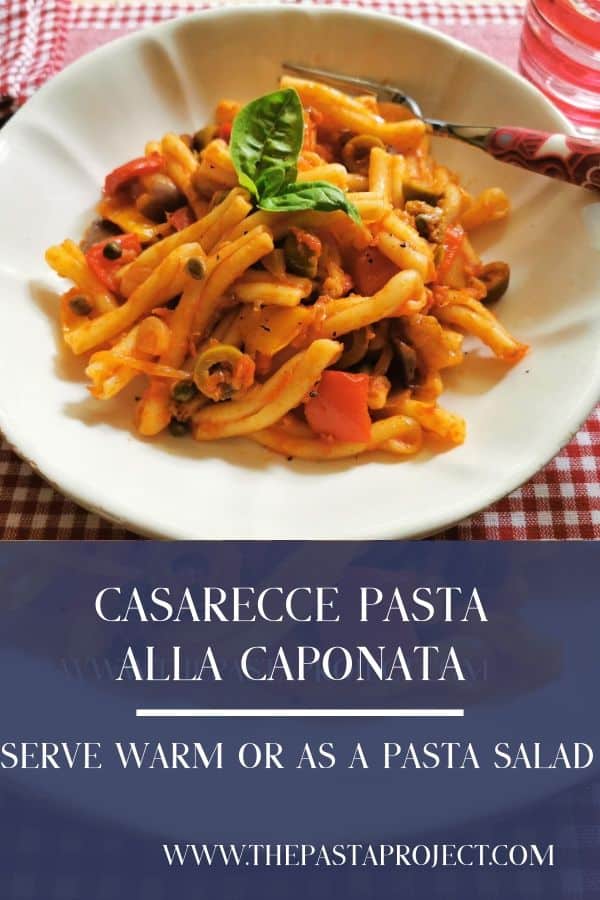
Of course, there are other companies that make good quality casarecce, for example; La Molisana, Rummo and Garofalo, who also make whole-wheat and gluten free versions. If you don’t have casarecce for your pasta alla caponata, you can use other short pasta such as penne, sedani, dischi volanti or olive leaf pasta.
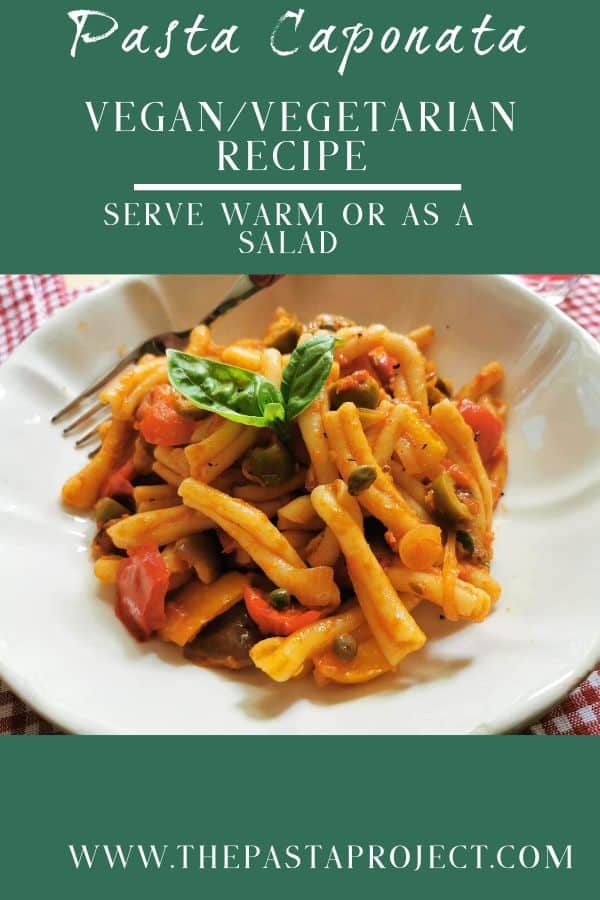
Let me know what you think.
Although pasta with caponata isn’t an old traditional combination, it’s become very popular. I’m sure if you try it, you’ll understand why. This recipe makes enough for 4 generous helpings of pasta plus some extra caponata to have as a side dish a day or two later.
If you do make this casarecce pasta caponata recipe, I’d love to hear how it turns out. Please write a comment here on the blog or post a comment on the Pasta Project Facebook page.
Your feedback means a lot to me!
Buon Appetito!
Other casarecce recipes on The Pasta Project
- Casarecce alla peperonata (sweet pepper sauce)
- Umbrian wild pea soup with casarecce
- Roasted red pepper pesto with casarecce
- Casarecce with Sicilian pesto
Want to make casarecce at home? Check out my new post for homemade casarecce 2 ways.
Save this recipe for later?
If you want to save this recipe for later, you can print it, bookmark this page or save it to Pinterest.
Pin for later.
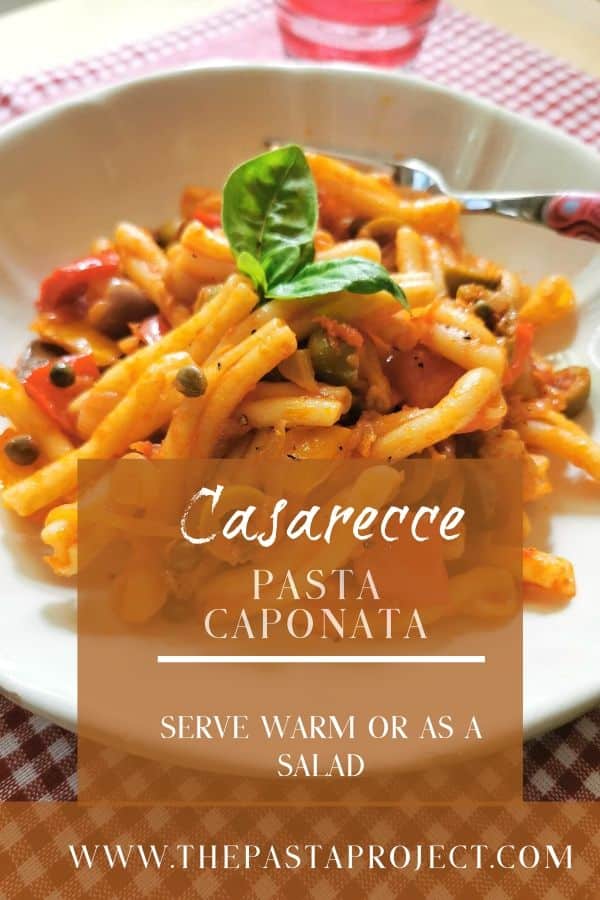
Want to know more about my life in Italy? Why not subscribe to my newsletter? New subscribers get a free series of recipe e-books too!
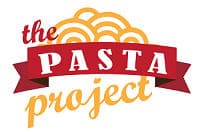

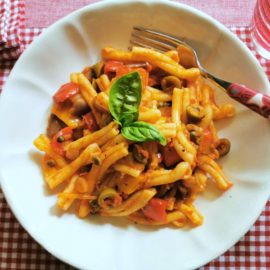
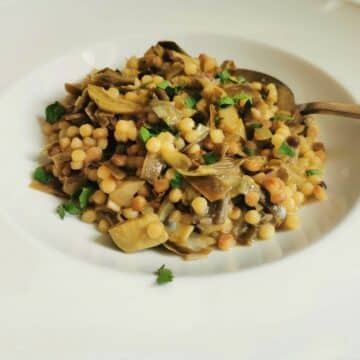
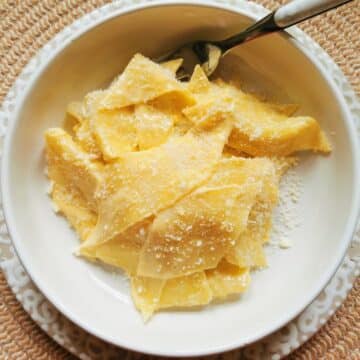
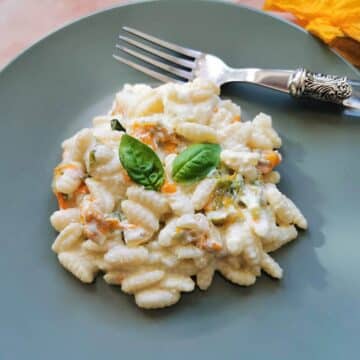
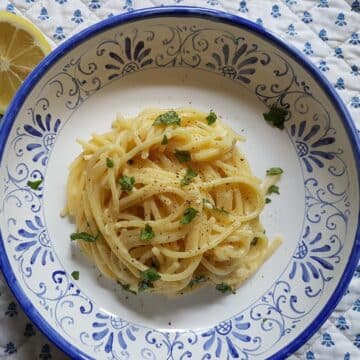
michele says
I just happened to have a Rosa Bianca eggplant in my fridge when this recent post on eggplant popped up. Yay! It really does make a difference using this kind of eggplant. This sauce tastes very, very good, and I really like the texture with the firmer eggplant. I have been eating it by the spoonful (cold). I will have some with focaccia (rosemary), and will try to save some for pasta, but it is a very addictive nibble. Another solid hit. Thank you.
Marian Locascio says
How much is a third of a glass of white wine vinegar? Not sure what that means. Would like to try this recipe.
Jacqui says
Hi Marian, thanks for your comment. A third of a glass of vinegar is approx equivalent to 4 tablespoons or 1/4 of a cup. I will correct the recipe to make it clearer. Do let me know how your caponata pasta turns out.
Steve Kirk-Cohen says
Good recipe thank you. A small housekeeping issue for you: you mention the peppers in the instructions but not in the ingredients list. The pic looked like 1/2 each red and yellow pepper, which is what I used. I also air-fried the aubergines having “harlequined” them first, taking off half the skin in strips. It cuts down on the oil content.
Jacqui says
Hi Steve, thanks for pointing out that the peppers are missing from the ingredient list. I've corrected it. I used one of each. I guess it depends on the size. I don't have an airfryer but I do sometimes baked eggplant in the oven instead. However, although healthier, I don't think they taste as good.
John says
You never said when to re add the eggplant
Jacqui says
Hi John thanks for your comment and pointing out the missing part about the eggplant in the instructions. I have now updated the recipe to include it in the finish and serve section.
Julián says
Delicious recipe, it is similar to the Spanish "pisto manchego".
Thanks
Lathiya says
The pasta caponata looks so delicious with few ingredients. I'm so glad that you gave two options to serve as warm or as a salad. That's genius.
Joyce says
Can’t go wrong with a beautiful pasta dish like this one! I love how beautiful it looks and taste! Great recipe
Gail Montero says
I have never made this but I'd surely love to give it a try as it looks so deliciously good! Great instructions, too!
Jar of Lemons says
This caponata dish looks so delicious! I love the flavors that you used in your recipe! Perfection!
Emily says
I love eggplant pasta! This recipe is delicious and a perfect summer meal!
Diana says
What a great authentic pasta recipe! I'm excited to make this recipe for my family.
Kari says
This looks like such a lovely dish to use up the veggies in my garden and I wish I could get my hands on that pasta. It reminds me of one I had in Dubai.